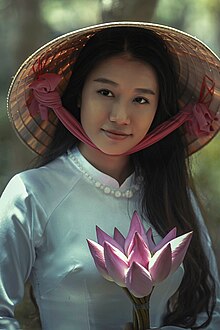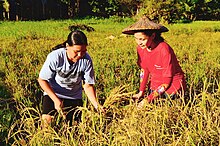

The Asian conical hat is a simple style of conically shaped sun hat notable in modern-day nations and regions of China, Taiwan, parts of Outer Manchuria, Bangladesh, Bhutan, Cambodia, India, Indonesia, Japan, Korea, Laos, Malaysia, Myanmar, Philippines, Nepal, Thailand, and Vietnam. It is kept on the head by a cloth or fiber chin strap, an inner headband, or both.
English terms for the hat include sedge hat, rice hat, paddy hat, bamboo hat, and—historically but now only offensively[1][2]—coolie hat.[3]
In Southeast Asia, it is known as do'un (ដួន) in Cambodia; caping or seraung in Indonesia; koup (ກຸບ) in Laos; terendak in Malaysia; ngop (งอบ) in Thailand; khamauk (ခမောက်) in Myanmar; salakót (ᜐᜎᜃᜓᜆ᜔), sarók, sadók, s'laong, hallidung, kallugong, and tabungaw among other names in the Philippines; and nón lá in Vietnam.[citation needed]
In East Asia it is called dǒulì (斗笠, literally meaning a "one-dǒu bamboo hat") in China; kasa (笠) in Japan; Le̍há (笠仔) in Taiwan/Formosa; and satgat (삿갓) in Korea.
In South Asia, it is known as jaapi (জাপি) in Assam (India); in Bangladesh it is known as mathal (মাথাল).[4]
Asian conical hats are, throughout Asia, primarily used as a form of protection from the sun and rain. When made of straw or other woven materials, it can be dipped in water and worn as an impromptu evaporative cooling device.[5]
In China, it was typically associated with farmers, while mandarins wore tighter circular caps, especially in the winter.[6] There are several conical hat types worn during the Qing dynasty (see Qing official headwear).
|
Main article: Kasa (hat) |
It is also widely understood in East Asia, most notably Japan, where they were known as kasa, as a symbol of Buddhism, as it is traditionally worn by pilgrims and Buddhist monks in search of alms.
Sturdier, even metal, variants, known as jingasa (battle kasa), were also worn by samurai and foot-soldiers in Japan, as helmets.[citation needed]
|
Main article: Salakot |


In the Philippines, the salakót is more commonly a pointed dome-shape, rather than conical, with a spike or knob finial. Unlike most other mainland Asian conical hats, it is characterized by an inner headband in addition to a chinstrap. It can be made from various materials including bamboo, rattan, nito, bottle gourd, buri straw, nipa leaves, pandan leaves, and carabao horn. The plain type is typically worn by farmers, but nobles in the pre-colonial period (and later principalia in the Spanish period) crafted ornate variations with jewels, precious metals, or tortoiseshell. These are considered heirloom objects passed down from generation to generation within families.[7][8]
The salakót was also commonly worn by native soldiers in the Spanish colonial army. It was adopted by Spanish troops in the early 18th century as part of their campaign uniform. In doing so, it became the direct precursor of the pith helmet (still called salacot or salacco in Spanish and French).[9]
|
Main article: Nón lá |
In Vietnam, the nón lá, nón tơi (“hats”), nón gạo (“rice hat”), nón dang (“conical hat”) or nón trúc ("bamboo hat") forms a perfect right circular cone which tapers smoothly from the base to the apex. Special conical hats in Vietnam contain colourful hand-stitch depictions or words. The Huế varieties are famous for their nón bài thơ (lit. poem conical hats) and contain random poetic verses and Chữ Hán, which can be revealed when the hat is directed above one's head in the sunlight. In modernity, they have become part of Vietnam's national costume.[10]
In India, Bangladesh[11] and Borneo, the plain conical hat was worn by commoners during their daily work, but more decoratively-colored ones were used for festivities. In Sabah, the colorful conical hat is worn for certain dances while in Assam they are hung in homes as decoration or worn by the upper classes for special occasions.[citation needed]
